| |
P08 Holster of
Leutnant Barfels
146th German Infantry Regiment
"1.
Masurisches Infanterie-Regt. Nr.146"
Photos and text by John Strott
Parabellum Model 1908 Pistol
and Its Holster
One of the most recognizable
pistol designs of WWI was the 9mm, semi-automatic Parabellum
Model 1908 pistol or P08. The pistol later became popularly
known as the Luger, in honour of its designer, Georg
Luger. The P08 was issued by the thousands to WWI German
combat units and so it is no surprise that these
weapons found their way into the hands of German Colonial
Troops and other deployed units. In addition to the pistol
itself, pistol accessories were specially designed and
issued to soldiers to carry the pistol on the person and
keep the pistol in serviceable condition.
One important
accessory was the P08 holster. Unique in appearance, the
P08 holster was made of leather and had a large pocket
covered by a leather flap that protected the pistol from the
elements and held it securely in place. In addition,
smaller pockets were incorporated inside and on the side of
the holster to hold a special gun tool, a cleaning rod, and
a spare ammunition clip. There were belt loops on the back
of the holster for attaching the holster to the soldier’s
accoutrement belt.
These leather holsters were made in the
thousands by hundreds of small manufacturing companies all
over Germany. For quality control, the holsters often bore
maker’s marks stamped or pressed into the leather that
included the maker’s name, maker’s location, and the year
when the holster was made. German Army Quartermasters from
the various army regions who purchased the holsters added
their own marks, “Bekleidungsamt”
marks or “BA” marks, stamped in black ink under the top
flap of the P08 holster. Individual German Regiments that
received P08 holsters from their quartermasters sometimes
impressed or stamped their own special unit marks on the
holsters. And on extremely rare occasions a solder
might "personalize" his equipment by adding his own name,
rank, and unit. For the military collector and historian
these various maker and issue marks provide vital clues
about the item's provenance.
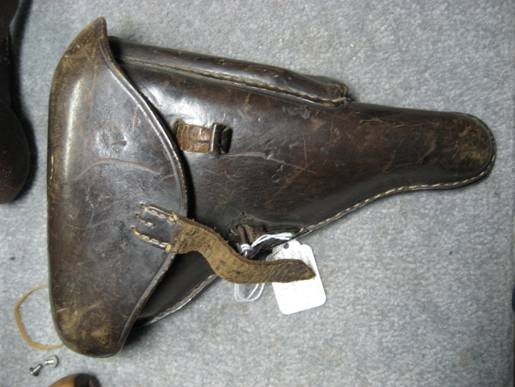
P08 Holster
The Find
I took a quick scan of a box of holsters before the show closed
for the day. There must have been over 100 holsters of all
sorts. I had no time to look at them all so I picked up the only
brown P08 holster and opened the lid. To my surprise I saw the
holster was both German army issue and regimentally unit
marked. It took no time at all to strike a deal and make the
purchase.
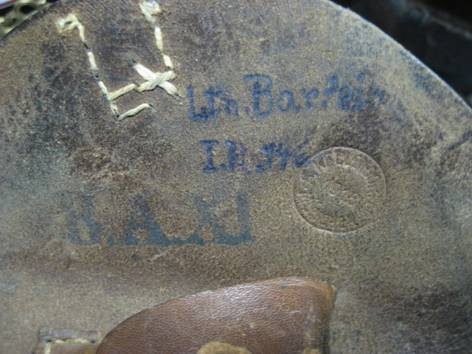
Markings Inside the
Holster Flap
Holster Markings Description
The P08 holster was signed in pencil with a rank (Ltn), name (Barfels)
and unit (IR 146) on the inside cover of the P08 holster top
flap. It also was stamped in black ink, under the top flap "BA
XI" indicating the holster was a German army issued holster.
The German officer had also carved his name
“BARFELS” with a sharp instrument on the outside of the spare
magazine pouch.
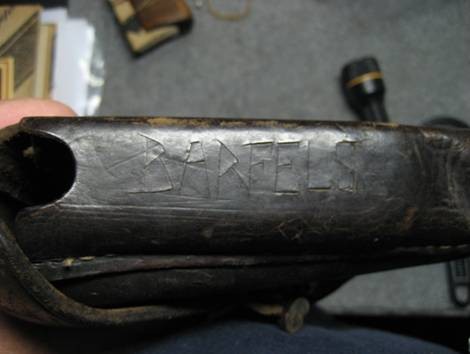
The Owner's Name Carved into the
Magazine Pouch
The holster was also maker marked "S
Kellendorf, Munchen 1918". The mark is a circular stamp, with
the maker and location encircling the date. That particular
maker is listed in John Walter's book, German Military Handguns
1879 -1918, and is listed as a manufacturer of P08 holsters.
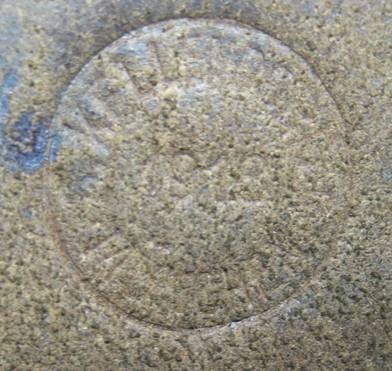
Maker's Mark
Historical Background
Leutnant Barfels was found on page 94 (about
3/4s of the way down on the right side of the page) of the 1919
Prussian Army Seniority List. It shows him as a member of the IR
146 which matched the inscription on the holster.

The Asienkorps was a German Expeditionary force
sent to assist the Ottoman war effort in late 1917. Originally
intended to assist in the recapture of Baghdad, it ended up
defending the Palestine Front in 1918. The
original Asienkorps consisted of three infantry battalions and
three artillery detachments. The battalions were numbered the
701st, 702nd and 703rd Battalions. In mid-1918 German Infantry
Regiment 146 arrived from the Macedonian Front. This unit
included many Tannenberg veterans. It was a long way from the
Masurian Lakes to the Jordan Valley.
The US Intelligence Report contained in 251
German Divisions in World War I indicates that IR 146 was part
of the 101st German Infantry Division originating from the 20th
Corps district of Eastern Prussia. The "IR 146 was in vicinity
of Monastir in December 1917 and was reported sent toward
Constantinople and Palestine in March 1918". In Palestine, the
IR 146 became a reserve unit supporting the Turkish Seventh Army
and battled with the British Army and Arabs lead by British
officer Lawrence of Arabia until the end of the war.
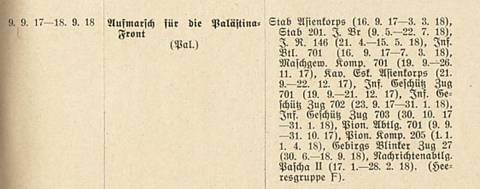
There are two primary entries pertaining to
the German Asienkorps from Die Schlachten und Gefechte des
Großen Krieges, 1914-1918 (compiled and published in 1919 by the
Great General Staff) showing individual German units. These
entries cover the periods of IR 146 combat in Central Palestine
and East Jordan as such:
• Positional
warfare in Central Palestine, 9 December 1917-29 April 1918
• Combat in East Jordan, 20 April 1918-20 September 1918
• Second Battle of East Jordan, 30 April 1918-6 May 1918
• Positional warfare in Central Palestine, 6 May 1918-18
September 1918, and in East Jordan, 7 May 1918-22 September 1918
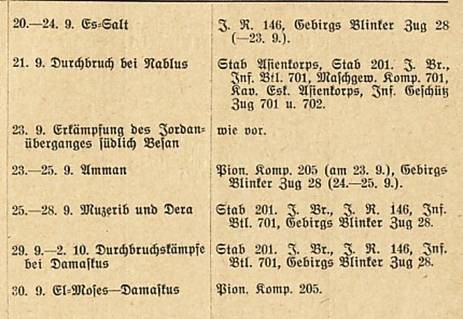
In Seven Pillars of Wisdom, T.E. Lawrence
described the retreating Turkish army as disintegrating and
losing coherence and order; however, he paid homage to his
German foes:
“Exceptions were
the German detachments; and here, for the first time, I grew
proud of the enemy who had killed my brothers. They were two
thousand miles from home, without hope and without guides, in
conditions mad enough to break the bravest nerves. Yet their
sections held together, in firm rank, sheering through the wrack
of Turk and Arab like armored ships, high-faced and silent. When
attacked they halted, took position, fired to order. There was
no haste, no crying, no hesitation. They were glorious.”
Conclusions about Provenance
It is considered a rarity to be able to fix
ownership of a military item (such as this P08 holster) to a
specific person, military unit, place, and time. Based upon the
evidence presented above a reasonable case can be made to
connect the holster (made in 1918), the unit (IR 146 unit marked
in holster), and the owner Lt Barfels (assigned to IR 146 in
1918 and whose name appears on the holster) to all be in Palestine
1918 (official records place the IR 146 in Palestine in 1918).
|
|